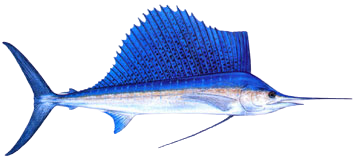Atlantic Sailfish
Other Names: Spindlebeak, Pez Vela

Physical description:
The Atlantic sailfish’s most prominent feature is their first, sail-like dorsal fin, commonly referred to as its “sail dorsal.” Coloration of the body is dark blue to dark blue-green on top, brown-blue on the sides fading to silver-white underneath. The upper body has light and dark blue spots scattered about, while the sides have blue-gray vertical stripes that are often broken. The body of an Atlantic sailfish is slender and they are extremely fast swimmers, having the ability to swim at speeds up to 60 miles per hour. There is an obvious lateral line that runs over the pectoral fin and back along the flanks. The body is covered with embedded scales that become less numerous and more variable in shape as the fish ages.
Range:
Atlantic sailfish migrate extensively throughout the tropical and temperate waters of the Atlantic Ocean. The full range is from about 40 degrees north to 40 degrees south latitude in the western Atlantic, roughly from Maine to Venezuela. They are found throughout the Gulf of Mexico and Caribbean. Feeding
Habits:
Favored feeding areas are near schools of baitfish in areas where there is a temperature change. They may form small groups of 3 to 30 members that forage together. It is possible that, like the Pacific sailfish, they may cooperate to capture their prey, using their fins to create a trap that prevents fish from escaping and taking turns to feed. They attack prey with their fins and spear and then consume the stunned fish headfirst. Their favored food is other fish, including mackerel, tuna, herring, ballyhoo, needlefish and mullet.
Sporting Qualities:
A highly popular target for sportfishermen, especially off the coast of Virginia, Atlantic sailfish are a prized trophy species. Their popularity is a result of the challenge of catching one using light tackle, their penchant for dramatic leaps out of the water, and their stunning beauty. Due to declining numbers resulting from overfishing, most Atlantic sailfish are now caught and released, though this is not as common off the coast of Mexico and Central America. Habitat:
Although they traverse the vast ocean waters, Atlantic sailfish favor areas near the Gulf Stream current. They stay at mid-range to surface depths above the thermocline, in waters with temperatures between 70 and 85 F. Despite being caught on the surface, most of their feeding appears to occur in mid-level depths near areas with underwater structures. Compared to their Pacific counterpart, they usually stay in deeper water year round, going to depths as great as 600 feet.



